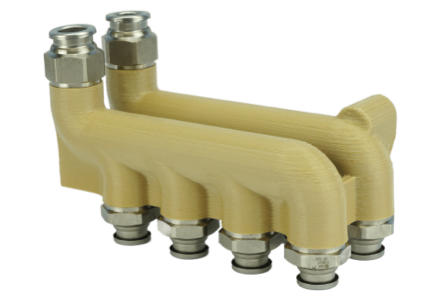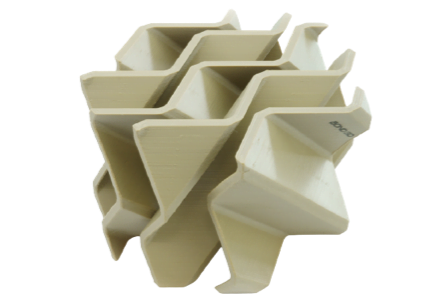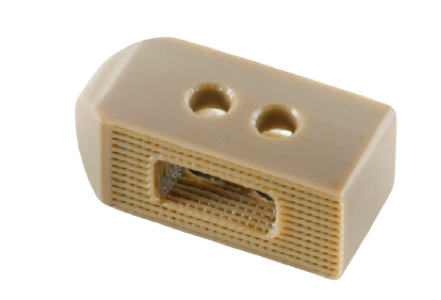Rewatch our webinar: Learn how to replace metal parts with 3D printed functional PEEK Polymer parts
 As many industries become increasingly aware of the benefits of metal-to-plastic conversion, 3D-printing is quickly becoming the method of choice for part manufacturing.
As many industries become increasingly aware of the benefits of metal-to-plastic conversion, 3D-printing is quickly becoming the method of choice for part manufacturing.
Processing and Manufacturing
When choosing a material for an engineering application, it is important to consider not only the material properties but also the processing and manufacturing techniques involved. PEEK polymers and metals are two popular material choices, each offering unique advantages in various industries.
The processing and manufacturing of PEEK polymers and metals differ significantly, which can impact the ease of fabrication, production costs, and overall efficiency. PEEK polymers are typically processed using injection molding or extrusion, which allows for the creation of complex part geometries and consistent repeatability. Metals can be processed through a variety of methods, such as casting, forging, and machining, providing flexibility in part design and manufacturing.
Fabrication methods
PEEK polymers are typically processed using injection molding or extrusion, which allows for complex part geometries and excellent repeatability. Metals can be processed using various methods, including casting, forging, and machining, providing flexibility in part design and manufacturing.
Machinability
PEEK polymers are relatively easy to machine, with lower cutting forces and reduced tool wear compared to metals. Metals can vary in their machinability, with some alloys being more difficult to machine than others.
Joining techniques
PEEK polymers can be joined using adhesive bonding or welding techniques, such as ultrasonic welding. Metals can be joined using a variety of methods, including welding, brazing, and mechanical fasteners.
Cost Considerations
Selecting the right material for a specific application is a critical decision in various industries, and cost considerations play a significant role in the material selection process.
Material cost
PEEK polymers are generally more expensive than metals on a per-unit basis. However, the specific cost of each material depends on factors such as grade, alloy, and market conditions.
Manufacturing cost
The processing and fabrication costs for PEEK polymers can be higher than those for metals, particularly if specialized equipment or tooling is required. However, the lower weight of PEEK components may offset this cost by reducing shipping and handling expenses.
Lifecycle cost
PEEK polymers typically have lower maintenance and replacement costs than metals, thanks to their high resistance to wear, corrosion, and chemical attack. Additionally, their lower weight can result in reduced energy consumption and environmental impact over the material’s lifecycle.
Critical parts & components made from PEEK. Printed by Bond3D
 Discover our 3D printed PEEK parts and components for every industry: electronics / semiconductor, energy, high-tech industry, medical, aerospace or automotive.
Discover our 3D printed PEEK parts and components for every industry: electronics / semiconductor, energy, high-tech industry, medical, aerospace or automotive.
Environmental Impact and Sustainability
In today’s increasingly environmentally conscious world, understanding the environmental impact and sustainability of materials used in various industries is crucial.
The environmental impact and sustainability of PEEK polymers and metals should be considered throughout their entire lifecycle, from production and processing to recycling and disposal. Factors such as energy consumption, recyclability, and carbon footprint are critical in assessing the overall environmental footprint of these materials.
Energy consumption
The production of PEEK polymers generally requires less energy than that of metals, resulting in a lower environmental impact. PEEK polymers are processed using methods such as injection molding and extrusion, which are typically more energy-efficient than metal production techniques like casting, forging, and machining. However, it is important to consider the energy required for processing and recycling each material, as these factors can also contribute to the overall environmental impact.
Recyclability
Both PEEK polymers and metals can be recycled, but the availability of recycling facilities and the ease of recycling differ depending on the material and location. Metals are generally more widely recycled than PEEK polymers, thanks to the existing infrastructure for metal recycling and the established market for recycled metals. PEEK polymers can be recycled through mechanical or chemical methods, but the infrastructure for recycling PEEK is less developed compared to metals. This may result in a higher proportion of PEEK waste ending up in landfills or incinerators. However, advances in recycling technology and an increased focus on circular economy principles are expected to improve the recyclability of PEEK polymers in the future.
Carbon footprint
The carbon footprint of PEEK polymers and metals varies throughout their lifecycle, from production to disposal. PEEK polymers generally have a lower carbon footprint than metals during production due to their lower energy consumption. However, the carbon emissions associated with the transportation and processing of PEEK polymers may offset some of these advantages, depending on the specific supply chain and manufacturing processes involved.
Metals, on the other hand, tend to have a higher carbon footprint during production, particularly for energy-intensive processes like smelting and refining. The carbon emissions from metal production can be reduced through the use of renewable energy sources and more efficient production methods. Additionally, recycling metals can significantly lower their overall carbon footprint, as recycling typically requires less energy than primary production.
Applications and industry-specific considerations
In the selection of materials for various applications and industries, both PEEK polymers and metals offer unique advantages that make them suitable for specific purposes. Understanding the distinct benefits and limitations of each material in different industry contexts can help engineers and decision-makers choose the most appropriate material for their needs. Performance characteristics, regulatory requirements, and long-term durability are some factors that should be taken into account when comparing PEEK polymers and metals in industry-specific applications.
PEEK polymers are particularly valued in the medical industry due to their biocompatibility, chemical resistance, and sterilization compatibility. PEEK’s ability to withstand high temperatures and maintain its mechanical properties makes it ideal for medical implants, such as spinal fusion devices and orthopedic implants, where metal alternatives may be prone to corrosion or cause issues related to metal sensitivity. In the aerospace and automotive sectors, the lightweight nature of PEEK polymers contributes to fuel savings and reduced emissions, as well as easier handling and assembly. The material’s excellent strength-to-weight ratio and resistance to harsh environments make it suitable for use in high-performance components, such as gears, bearings, and seals, where traditional metals may face challenges related to weight and wear.
On the other hand, metals have a long history of use in various industries and have established themselves as reliable and versatile materials. For instance, in the construction and infrastructure sectors, metals such as steel and aluminum are often preferred for their high strength, durability, and recyclability. These characteristics make metals suitable for long-lasting infrastructure projects, contributing to reduced waste and a more sustainable built environment. In the electronics industry, metals like copper and gold provide excellent electrical conductivity and reliability in applications such as wiring systems, connectors, and circuit boards, where PEEK polymers’ insulating properties may not be desirable.
Conclusion
In conclusion, the comparison between PEEK polymers and metals highlights the unique advantages and limitations of each material in various aspects, including mechanical, thermal, and electrical properties, as well as processing, manufacturing, cost, and environmental considerations. While PEEK polymers offer excellent strength-to-weight ratio, chemical resistance, and insulating properties, metals provide a diverse range of characteristics depending on the specific alloy and treatment, often excelling in strength, thermal conductivity, and electrical conductivity.
When selecting materials for engineering projects, it is essential to consider the specific application, project requirements, and overall objectives. In many cases, PEEK polymers may be the preferred choice due to their high performance, lightweight nature, and lower environmental impact, offering unique benefits in industries such as electronics / semiconductor, energy, aerospace, automotive, and medical applications. However, it is crucial to evaluate the suitability of PEEK polymers on a case-by-case basis, as certain applications may still require the use of metals for their specific properties and characteristics.
To make the most informed decision when selecting materials, it is highly recommended to consult with materials engineers and industry experts who can provide guidance based on their experience and knowledge of PEEK polymers and metals. By carefully considering the unique advantages and limitations of each material and seeking expert advice, engineers and decision-makers can confidently choose the ideal material to meet their project requirements and contribute to a more sustainable and efficient future.
Ready to start printing with PEEK polymers?
 Curious to know more about how PEEK polymers can be a value in your industry? Contact our team!
Curious to know more about how PEEK polymers can be a value in your industry? Contact our team!
Overview of comparison of PEEK polymers versus metal (stainless steel)
| Property/Aspect |
PEEK Polymers |
Metals |
| Mechanical Properties |
High strength-to-weight ratio
Excellent elongation, impact resistance
High fatigue resistance |
Wide range of properties depending on the alloy |
| Thermal Properties |
Low thermal conductivity
High heat resistance (up to 260°C) |
High thermal conductivity (varies by alloy)
Broad range of temperature resistance |
| Chemical Resistance |
Highly resistant to chemicals and corrosive environments |
Varies depending on the alloy and treatment |
| Electrical Properties |
Excellent electrical insulator
Low electrical conductivity
High dielectric strength |
Conductive (unsuitable for insulation) |
| Fabrication Methods |
Injection molding, extrusion |
Casting, forging, machining |
| Machinability |
Relatively easy to machine
Lower cutting forces, reduced tool wear |
Varies depending on the alloy |
| Joining Techniques |
Adhesive bonding, ultrasonic welding |
Welding, brazing, mechanical fasteners |
| Material Cost |
Generally more expensive than metals |
Varies depending on grade, alloy, market conditions |
| Manufacturing Cost |
Can be higher due to specialized equipment |
Generally lower |
| Lifecycle Cost |
Lower maintenance, replacement costs
Reduced energy consumption, environmental impact |
Higher maintenance, replacement costs |
| Energy Consumption (Production) |
Lower energy consumption |
Higher energy consumption |
| Recyclability |
Less developed infrastructure for recycling
Recyclable through mechanical or chemical methods |
Widely recycled, established infrastructure
Energy-efficient recycling processes |
| Carbon Footprint |
Lower carbon footprint during production
Transportation and processing may offset some advantages |
Higher carbon footprint during production
Recycling can significantly lower overall carbon footprint |




 As many industries become increasingly aware of the benefits of metal-to-plastic conversion, 3D-printing is quickly becoming the method of choice for part manufacturing.
As many industries become increasingly aware of the benefits of metal-to-plastic conversion, 3D-printing is quickly becoming the method of choice for part manufacturing.





 Discover our 3D printed PEEK parts and components for every industry: electronics / semiconductor, energy, high-tech industry, medical, aerospace or automotive.
Discover our 3D printed PEEK parts and components for every industry: electronics / semiconductor, energy, high-tech industry, medical, aerospace or automotive.


 Curious to know more about how PEEK polymers can be a value in your industry? Contact our team!
Curious to know more about how PEEK polymers can be a value in your industry? Contact our team!